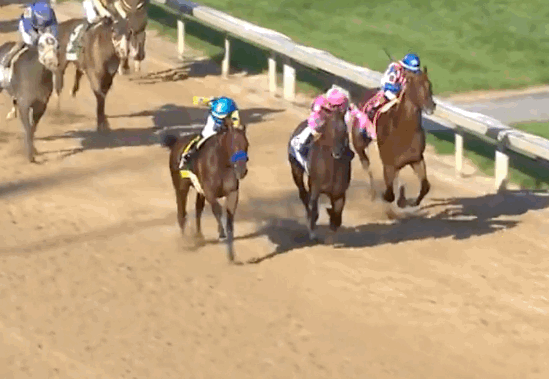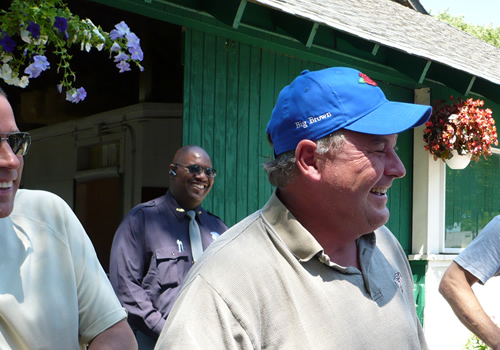Kentucky
Dick Jerardi on American Pharoah (subscription only):
Some think the Derby might knock him out. I see it another way, that the Derby may have gotten American Pharoah the fitness he never was able to get this winter. If you think about it, he had less preparation than any horse in the race and won anyway. The Derby had to be worth five workouts. I think his career-best performance is coming May 16 at Pimlico.
That’s my bet. American Pharoah had to exert himself to win last Saturday. The effort should sharpen him for the Preakness.

Victor Espinoza’s whip use on Pharoah during his Derby run will be reviewed (beware, that’s a Courier-Journal paywall-popup link):
Chief state steward Barbara Borden told The Courier-Journal on Wednesday that Kentucky racing officials plan to look at the stretch run and Espinoza’s tactics again, though, “We watched it many, many times prior to making it official, and that wasn’t anything that got our attention.”
Borden said there’s no set limit in Kentucky for how many times a jockey can whip a horse during a race. As for American Pharoah’s Derby win, she said the ride “didn’t stand out to us to be super excessive.”
Kentucky’s rules on riding crop use allow plenty of latitude, requiring “a jockey who uses a riding crop during a race shall do so only in a manner consistent with exerting his or her best efforts to win,” and specifying that the rider:
Show the horse the riding crop and give the horse time to respond before striking the horse;
(b) Having used the riding crop, give the horse a chance to respond before using it again; and
(c) Use the riding crop in rhythm with the horse’s stride.
See section 15 of the KHRC regulations for the full text.
The issue of how many times Espinoza struck American Pharoah came up when a Bloomberg recap by David Papadopoulos appeared the morning after the Kentucky Derby with the sensational headline, “American Pharoah Whipped 32 Times in Victory” (both New York Times reporter Joe Drape and Daily Racing Form correspondent Jay Privman also noted the number of strikes in their post-race analysis). Papadopoulos’ point was more about what the whipping said of Pharoah’s effort and his chances for the rest of Triple Crown season, although you can read some judgement of Espinoza’s tactics in the comparison with Joel Rosario on fourth-place finisher Frosted:
Beyond being aesthetically unpleasing to watch, so many blows can take a lot out of a horse, each one acting as a forceful prodding to try harder. And at some point, they stop being effective. Stronger-finishing jockeys, like Joel Rosario, who rode fourth-place finisher Frosted, rely much less on the stick to drive their horses to the finish line. Rosario hit Frosted only four times as he surged toward the leaders late in the Derby.
For comparison, Espinoza struck California Chrome approximately 20 times on the way to his win in the 2014 Kentucky Derby. All after the eighth pole, and mostly timed to Chrome’s stride. He was still a bit free-handed with the crop, but less desperate, as Chrome was in the lead from earlier in the stretch.
In a conversation about whip use on Twitter, Sid Fernando commented “[U]ntil Bloomberg guy counted, AP whip didn’t even register to me as [Rachel Alexandra’s] did [in the 2009 Woodward].” That may have been the last time there was a high-profile flap about how much a jockey used his crop in a stakes race. Rachel Alexandra was struck 21 times by rider Calvin Borel on her way to winning. As Steven Haskin wrote then for the Blood-Horse:
Did Rachel need to be hit 21 times? Only Borel can answer that. Unlike the British stewards, American stewards pay no attention to such things, so we’ll just have to assume Borel felt the situation was desperate enough to resort to such measures.
I suppose we’ll have to assume the same about this year’s Derby.
When Kentucky mandated last year that state veterinarians give pre-race Lasix shots, in place of private vets, the results were eye-opening, reports Ryan Goldberg in the final installment of TDN’s drugs in racing series (PDF):
Besides the volume of Lasix [which declined], murkier drugs largely disappeared from post-race tests. Scollay said she had seen evidence that a drug called GABA, short for gamma-aminobutyric acid, was commonplace in Kentucky. The amino acid, which is present in the supplement “Carolina Gold,” is endogenous to horses as well as humans — it’s the predominant receptor blocker in the central nervous system. It has a pain-mitigating and calming effect that can conserve a horse’s energy prior to a race. However, because it’s naturally occurring and leaves a horse’s system within three to four hours, finding suspicious levels in post-race tests is difficult.
Its use in Kentucky was apparently curtailed once regulatory vets came in. The “noise” in post-race samples all but departed. Lasix is administered within four hours of a race; private vets were apparently giving GABA at the same time. There was no trace.
Wow. I wonder if the same thing happened in New York after the NYRA detention barn — in which horses were monitored for six hours before a race and only state vets could administer Lasix — opened in 2005, and if the concentration of Lasix in the blood, as well as the presence of other drugs or supplements in test samples, rebounded after it closed in 2010?

Dutrow in happier days.
“RICK DUTROW DONE,” was the search term that led someone to Railbird this morning, presumably seeking more on yesterday’s shocking news that the KHRC denied the trainer a Kentucky license because of his lengthy list of violations and license application inconsistencies. “I never thought I’d see the day when a big-name trainer was held to task for his misdeeds,” tweeted Ryan Goldberg. Regardless of what happens next, there’s no denying, as the Racing Post put it so well, that “controversial trainer Rick Dutrow hit a new career low” on Wednesday. He has a chance to hit another in May, when New York reviews his license, or possibly when his biggest client, IEAH, pulls its stock from his barn. “Obviously, we can’t be in a position where our horses can’t run in certain jurisdictions,” Michael Iavarone told DRF.
A restraining order will make it possible for Amen Hallelujah, entered by Dutrow before his hearing, to start in the Vinery Madison today*.
Brooklyn Backstretch has posted a timely interview with RCI president Ed Martin on Dutrow’s record and the letter Martin wrote to the NYSRWB in February calling for an examination of his license: “His record is his record.” That’s just it, and Dutrow doesn’t help himself when he makes excuses:
He also said any misinformation on his license applications were not intentional but were due to the fact others completed the paperwork for him, and he just signed it.
Or refuses to take responsibility:
Dutrow said that was because he could not remember whether the incident occurred within the time frame stipulated on the application, but the committee could get copies of his criminal record in order to get the specifics.
What made the KHRC decision all the more interesting was the context. It’s spring, and racing seems to be in the mood to clean house. The movement to ban raceday medications is suddenly gaining real momentum. The latest group to sign on is the Breeders’ Cup, which announced today that its board:
… also endorsed in principle the recently announced recommendation of the Association of Racing Commissioners International (RCI) to eliminate the use of race-day medications in North American racing and decided to appoint a sub-committee with the objective of developing a plan and a timetable for the elimination of race-day medication in the Breeders’ Cup World Championships.
American racing is going drug-free! I don’t see what could stop … oh, right:
Saying they support efforts to limit race-day medications, two prominent Thoroughbred trainers said they hope the initiatives do not go so far as to ban use of the anti-bleeder drug known as Salix.
The horsemen are going to take to some work to win over:
The Kentucky Horsemen’s Benevolent and Protective Association, which represents all licensed owners and trainers, hasn’t discussed stricter medication rules, said president Rick Hiles, a trainer.
“We believe in therapeutic medications to help the animals,†he said, “so we’re probably not going to endorse it.â€
But what about the celebrity owners, Mr. Hiles? Spare them a thought, as TDN publisher Barry Weisbord does in a column appearing yesterday:
When a prominent t.v. personality such as Bobby Flay or a successful young businessman like Mike Repole or Kevin Plank — any of whom could participate in any sport they’d like — decides to spend his free time participating in Thoroughbred racing, what do we do? We make it tougher on him by forcing him to continually answer this question: Why do you spend your time in an industry which drugs its athletes?
Asking them to answer that question, be it in the lead-up to a major race, or when they’re receiving some other recognition in their professional lives and the topic of racing comes up, is not only unfair, but has to diminish their enjoyment of their participation in racing.
Actually, I get this. When I talk to people who don’t know much about racing, the question of drugs often comes up, and I find myself choosing my words carefully and trying to tell the truth but not make it sound so, so bad. There’s a perception of shadiness attached to even the legal medications, regardless of their therapeutic qualities. Banning raceday drugs is about doing right by horses, and giving horseplayers and casual fans reason to trust in the integrity of the game — which is why all the meds, including Lasix, must go.
*Turns out, Amen’s start took a last-minute trainer change, an unusual move with implications for trainer responsibility (via @o_crunk).
4/15/11 Addendum: This is pretty funny:
Sallusto was not on the grounds for the [Vinery Madison], leaving jockey John Velazquez as the sole person to answer questions in the wake of the filly’s runner-up effort.
“No one,” was Velazquez’s response when asked who gave him pre-race instructions.
When asked whether he had talked with the trainer after the race, Velazquez replied, “Who is the trainer?”
Copyright © 2000-2023 by Jessica Chapel. All rights reserved.